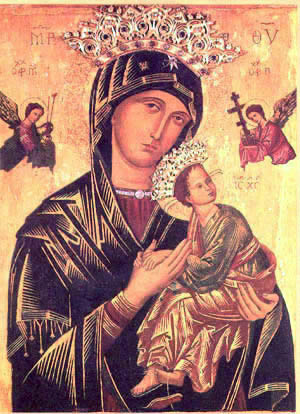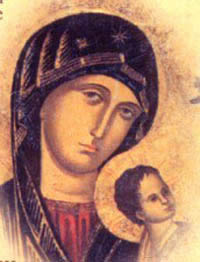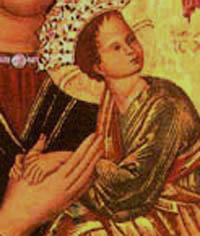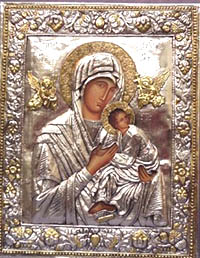 |
Feast Days of Our Lady
Our Lady of Perpetual Help – June 27
Prof. Plinio Corrêa de Oliveira
Devotion to Our Lady of the Perpetual Help was born on the Island of Crete. This explains the Byzantine influence one notices in the picture. The persons represented in this picture may shock the modern sensibility accustomed to saints depicted with the faces of dolls. This picture was made in different times and is very expressive.
The devotion to Our Lady of Perpetual Help was spread in the Church by the Redemptorist priests. It is a very beautiful invocation since it expresses Our Lady’s unflagging mercy toward us. Perpetual help means an assistance, an act of mercy, an act of uninterrupted piety that never ceases toward us. The word never means that this assistance will not cease anywhere, any time or for any reason. That is, even if a person is in the worst possible situation, Our Lady always will help one who prays to her.

Our Lady of Perpetual Help
|
The picture, as you see, has a gold background. These unadorned gold backgrounds were characteristically used in paintings of the old Eastern Roman Empire and during part of the Middle Ages. The Angel Musicians of Fra Angelico, for example, have golden backgrounds. The gold background was used when very important personages were painted. Western art normally places a great dignitary on an ornate chair in an elegant room, standing next to a gracefully draped window or in a beautiful outdoor scene. The Eastern mentality prefers to set them out of the time, immersed in full glory, that is, with a golden background.
The gold, therefore, represents the glory of Our Lady as Queen of Heaven. She has a halo around her head, which is also gold, as does the Divine Infant. Over the halo is a gold crown inlaid with precious stones. The crowns of Our Lady and the Christ Child have a similar shape. The base of each sits close to the head, has a thin rim, and is topped with fabulous ornate designs. On the rim are inlaid rubies, on ornate arches
in the middle layer are sapphires, and on the highest level is a row of emeralds or diamonds - I can't distinguish precisely which
it is on this particular reproduction. The crown of the Child follows the exact same pattern.
Our Lady is wearing a deep blue mantle that covers her shoulders and head. Below the crown and over her forehead is a refulgent star made of precious stones; to its left is a golden design that looks like either a star or a cross.
If you note carefully, you see that Our Lady is wearing a red tunic under her blue mantle. The red appears at her neck and the ends of her sleeves. This red tunic closes at her neck with an exquisite band of diamonds.
The Child Jesus is seated on Our Lady's left arm. He rests easily in her arms, like a child who is very used to being near his mother and enjoys being there. He is, however, distracted by something else to which he turns his gaze. In my opinion the artist made a mistake
in his representation of the Child. He appears more like a seven- or eight-year-old boy rather than a baby who should be carried in the arms of his mother. By the way, this picture is not considered a work of art. It is regarded as an excellent work of piety with some very good artistic points and some defects.
The Child has a rose belt with a greenish tunic. He also has a mantle that falls naturally near the left hand of Our Lady making numerous beautifully folded pleats. Almost all the pleats in the picture seem to me very well placed and natural.
There are two Angels presenting the Infant with the instruments of the Passion; at left an Angel with a red tunic and a green mantle shows Him the lance and the gall-sop, at right an Angel wearing a red tunic shows him a three-armed cross and the nails.
What can be said about all this?

Above, the features of Our Lady are very expressive; below, the position of the hands symbolize His dependence on her

|
The features of Our Lady are very expressive. The picture shows her in a very maternal attitude. She is a mother who holds her Son with an extraordinary intimacy and a remarkable affection. It shows the familiarity of Our Lady with the God-Man. At the same time, she has a profoundly recollected gaze that transmits the respect and veneration she has for Him. She is praying
to Him while she holds Him. She is certain that she is holding God Incarnate Himself in her arms.
Parts of the face of Our Lady are not well painted. Her neck appears somewhat too rigid. The mouth is delicate but the nose is perhaps a bit too long. These are several points that do not allow the picture to be considered a perfect work of art. But they are secondary defects, because an authentic art is present in the recollected expression of her physiognomy, in her noble pose, and in the affection the pose reveals.
The picture is rich in symbolism. The dark blue mantle represents mothernood, while the red tunic symbolizes virginity. Therefore, depicting her wearing both red and blue shows that she is both Mother and Virgin. It is a delicate way to insinuate the miracle of her virginity before, during and after the parturition.
For me, the most touching symbolism is the gesture of the Child holding Our Lady's hand. His right hand is behind her thumb and his left hand inside her hand in a way that gives Our Lady's hand control over the hands of the Divine Infant. Symbolically, one who holds the hands of another holds him entirely. So, this way of presenting the Infant's hands expresses that she can do everything she wants with Him; everything she asks He agrees to; it expresses the power of her prayer. With great facility the artist represents the dependence of the Child-God upon Our Lady.
One characteristic of this Byzantine icon is that while the symbolism is very rich, it does not say the same to everyone. The symbols are there to be discovered by those who spend time analyzing them and contemplating them.

A silver-plated icon of Our Lady of Perpetual Help
|
The two Angels represent the Passion that the Child will have to face. They are prophesizing the Passion to Him. That is, we are invited to see in Him the Redeemer of mankind, the One who was awaited by the Prophets to save mankind.
There is also a very picturesque detail: It is the sandal hanging from the Child's right foot by only one string. It symbolizes the sinner who is still linked to Our Lord by one last string: devotion to Our Lady.
The Greek initials at the top on either side of the crown stand for “Mother of God.” The initials over the angel at top left reads “St. Michael the Archangel,” at right, “St. Gabriel the Archangel.” Under the angel at right are the Greek initials for “Jesus Christ.”
The star on the veil of Our Lady indicates that she is the Star of the Sea, the guide in this life to lead all who desire to the port of Heaven.
Let us always ask Our Lady to protect us with her perpetual help and mercy.


  | | Prof. Plinio Corrêa de Oliveira | |
The Saint of the Day features highlights from the lives of saints based on comments made by the late Prof. Plinio Corrêa de Oliveira. Following the example of St. John Bosco who used to make similar talks for the boys of his College, each evening it was Prof. Plinio’s custom to make a short commentary on the lives of the next day’s saint in a meeting for youth in order to encourage them in the practice of virtue and love for the Catholic Church. TIA thought that its readers could profit from these valuable commentaries.
The texts of both the biographical data and the comments come from personal notes taken by Atila S. Guimarães from 1964 to 1995. Given the fact that the source is a personal notebook, it is possible that at times the biographic notes transcribed here will not rigorously follow the original text read by Prof. Plinio. The commentaries have also been adapted and translated for TIA’s site.
|
Saint of the Day | Home | Books | CDs | Search | Contact Us | Donate

© 2002- Tradition in Action, Inc. All Rights Reserved
|
 |

|